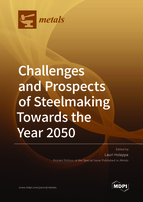Challenges and Prospects of Steelmaking Towards the Year 2050
A special issue of Metals (ISSN 2075-4701).
Deadline for manuscript submissions: closed (31 May 2020) | Viewed by 166515
Special Issue Editor
Interests: fundamentals of metallurgical processes; sustainability in steel production; converter processes; clean steel production; inclusion engineering; Tundish metallurgy; slag chemistry
Special Issue Information
Dear Colleagues,
The world is experiencing a period of imminent threat regarding climate change. The IPCC report 2018 defined the jointly approved target of limiting global warming to 1.5°C by 2050, which means deep cutting of CO2 emissions comprehensively. These challenges concern all human activities, including steel production.
Steel is central to modern society. It is necessary for infrastructure, buildings, transportation vehicles, and energy production. The annual consumption of steel is about 1.6 billion tons, and this is growing due to global progress. Steel production is quite an energy-intensive branch of industry. Due to the central role of coal/coke in ironmaking, carbon dioxide emissions are large corresponding to approximately 7 % of the total anthropogenic CO2 emissions. On the other hand, steel is a necessary material to solve the global dilemma to radically decrease the use of fossil energy and increase the share of renewable energy. The challenge of the steel industry is thus dual: on one hand, it must strongly cut its own CO2 emissions by improving and developing the process route, and on the other hand by developing new steel grades with improved properties in order to achieve a longer life cycle and better recyclability.
This themed Issue aims to review the present situation of steel production, energy consumption, and CO2 emissions. The potential methods to decrease CO2 emissions in current processes via improved energy and materials efficiency, increasing recycling, and utilizing alternative energy sources are considered. Development programs for current and novel innovative processes as well as trends of alternative energy sources are surveyed. Additionally, the role of steel as an integral part of the global circular economy should be discussed. As a whole, the target of this Issue is to give a holistic overview of the current situation and challenges, and a comprehensive cross-section of the potential technologies and solutions for the global CO2 emissions problem.
Prof. Lauri Holappa
Guest Editor
Manuscript Submission Information
Manuscripts should be submitted online at www.mdpi.com by registering and logging in to this website. Once you are registered, click here to go to the submission form. Manuscripts can be submitted until the deadline. All submissions that pass pre-check are peer-reviewed. Accepted papers will be published continuously in the journal (as soon as accepted) and will be listed together on the special issue website. Research articles, review articles as well as short communications are invited. For planned papers, a title and short abstract (about 100 words) can be sent to the Editorial Office for announcement on this website.
Submitted manuscripts should not have been published previously, nor be under consideration for publication elsewhere (except conference proceedings papers). All manuscripts are thoroughly refereed through a single-blind peer-review process. A guide for authors and other relevant information for submission of manuscripts is available on the Instructions for Authors page. Metals is an international peer-reviewed open access monthly journal published by MDPI.
Please visit the Instructions for Authors page before submitting a manuscript. The Article Processing Charge (APC) for publication in this open access journal is 2600 CHF (Swiss Francs). Submitted papers should be well formatted and use good English. Authors may use MDPI's English editing service prior to publication or during author revisions.
Keywords
- Steel industry
- Energy consumption
- Energy saving
- Waste energy
- By-products
- Sustainability
- Mitigation of CO2 emissions
- Innovative processes
- Future challenges
- Circular economy






